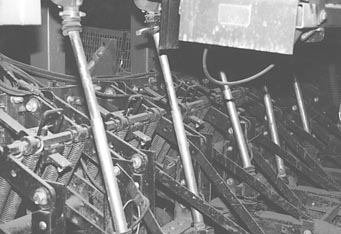
You don't have to spend a lot to make a drill perform at its peak, according to Larry Conrad who made a few simple modifications to his 24-row (15-in.) Great Plains Soybean Special. He uses the drill to no-till both corn and soybeans.
"There was nothing really complicated but it makes my drill perform better than the day it came off the assembly line," says Conrad, Delta, Iowa.
To plant corn in 30-in. rows, Conrad replaced one of the rubber tires on each pair of closing disks with an iron ring. The 3/4-in. wide rings are 1 1/2-in. larger in dia. than the original rubber tire so they run 3/4-in. deeper.
The conventional disk mounts in the rear offset hole, while the modified disk mounts in the forward hole.
"Because the iron ring is narrower and extends out farther than the rubber tire, and because it runs 2 to 4 in. ahead of the rubber-edged disk, it works as a furrow closer by collapsing one side of the furrow ahead of the other wheel and pushing soil over the seed," he says. "In softer soil, the rubber provides support for the iron wheel and prevents over-aggressive soil movement often associated with cast iron closing wheels.
"The iron wheel also provides better root worm insecticide incorporation by throwing more soil.
"There were no negative effects, such as throwing seed out of the furrow, building up with mud, or dragging trash along."
Conrad says the iron ring design could be used on any drill or planter used to plant corn.
To plant soybeans, Conrad made new seed tubes for his drill out of electrical conduit. Each two-piece tube is made of 1-in. dia. and 3/4-in. dia. conduit. The smaller conduit telescopes inside the larger piece so the tubes flex with the drill.
"We pinched the smaller tube so it's tear-drop shaped, small enough so only one seed rolls down the tube at a time, so there's never a chance of getting doubles. I use a Vanguard drill seed sensor and Dickey-John population monitor and I know I've increased my drill's accuracy to almost 100 percent, compared with about 85 percent for the original rubber seed tubes."
Conrad says the seed tubes could be made to fit any drill.
